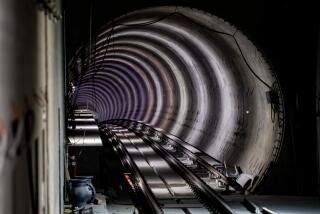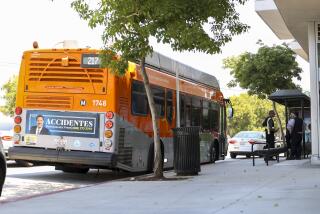Opposition Builds to Legislation : Transit Agency Opposes Light-Rail Ban
Saying the legislation could jeopardize the San Fernando Valley’s chance for a light-rail system, county transportation officials voted Wednesday to oppose a bill to ban trolley construction in North Hollywood and Van Nuys for a decade and postpone Metro Rail work in the Valley for two years.
The Los Angeles County Transportation Commission, which is building a countywide light-rail system, was reacting to a bill endorsed Tuesday by the Assembly Ways and Means Committee.
Several Valley business leaders also said Wednesday that they plan to fight the bill, and one group announced plans for a letter-writing campaign urging a veto by Gov. George Deukmejian. Nonetheless, Sen. Alan Robbins (D-Van Nuys) said he remained committed to the legislation he co-sponsored with Assemblyman Tom Bane (D-Van Nuys). Robbins predicted that the bill will sail through the Legislature and be signed by the governor.
Robbins and Bane say they were responding to widespread opposition to light-rail construction among their North Hollywood constituents, who fear that trolley noise and vibrations will ruin their neighborhoods.
A well-organized group of North Hollywood light-rail opponents has been seeking help from Robbins and Bane since March, when the County Transportation Commission voted for an environmental study of five possible light-rail routes in the valley that included two routes through North Hollywood.
Business Support
The Robbins-Bane bill would effectively end consideration for 10 years of the two routes, both of which would link the North Hollywood Metro Rail station with Warner Center.
One of the routes would follow Chandler Boulevard east of the San Diego Freeway and Victory Boulevard west of the freeway. The other route would follow Victory the length of the Valley.
The Chandler-Victory route has the support of many business leaders and the County Transportation Commission staff.
Left as possible routes would be the Ventura Freeway, the Los Angeles River and Southern Pacific railroad mainline, which crosses the Valley from Burbank Airport to Chatsworth.
The commission had expected to select a final route when the study is completed in September, 1988.
Los Angeles City Councilman Michael Woo, a commission member, appeared to reflect majority sentiment Wednesday in saying he opposed the Robbins-Bane bill because it could make the environmental study vulnerable to a legal challenge and thereby harm the Valley’s chances for a light-rail system.
The Valley is in competition for money with a proposed downtown-to-Pasadena light-rail route. Because the commission expects to have enough money for only one route in the next decade, court delays could make the downtown-to-Pasadena route more attractive.
David R. Williams, president of United Chambers of Commerce of the San Fernando Valley, said his group opposes the Robbins-Bane bill because “we feel strongly that the Chandler-Victory and Victory routes should be kept in the study.”
Guy McCreary, chairman of Fair Alignment Is Right, a business group, said he and others were organizing a letter-writing campaign to the governor urging completion of the study.
None of the opposition to the Robbins-Bane bill stems from its Metro Rail provision. That delay is supported by elected officials, homeowners and transportation representatives in Studio City and North Hollywood.
One-Year Limit
The Metro Rail provision would amend a 1984 state law also sponsored by Robbins. It requires the Southern California Rapid Transit District to begin work on a 2.4-mile segment of Metro Rail between Universal City and the subway’s northern terminus, at Chandler and Lankershim boulevards in North Hollywood, within one year of the Sept. 29, 1986 Metro Rail ground-breaking in downtown Los Angeles.
In recent months, most local leaders have agreed that it is prudent to delay the noise and congestion that stem from tunnel work until it is certain that federal money will be available to connect the Valley segment with downtown. Planners say that could be four years or more.
More to Read
Sign up for Essential California
The most important California stories and recommendations in your inbox every morning.
You may occasionally receive promotional content from the Los Angeles Times.









